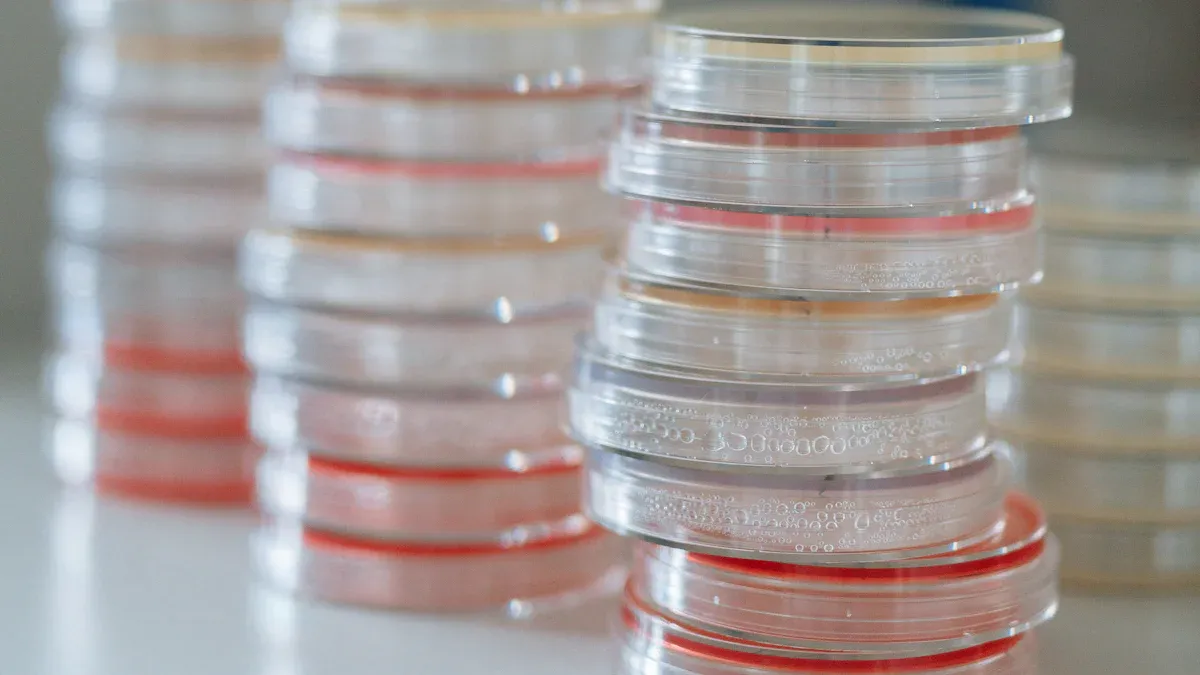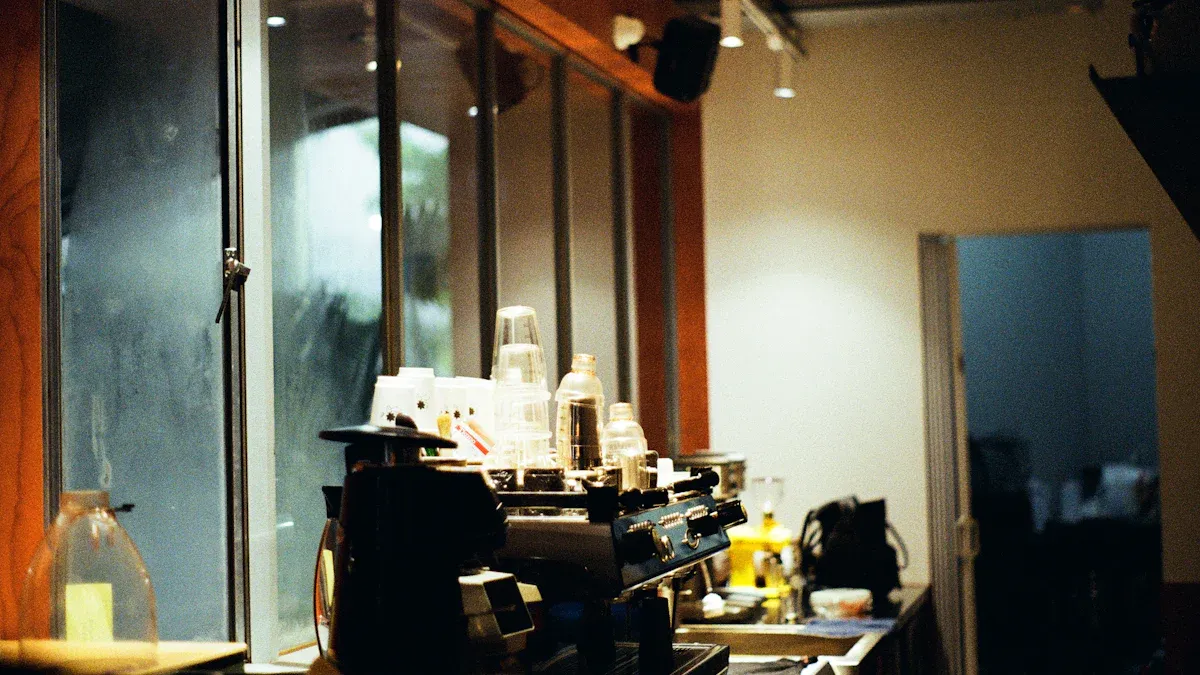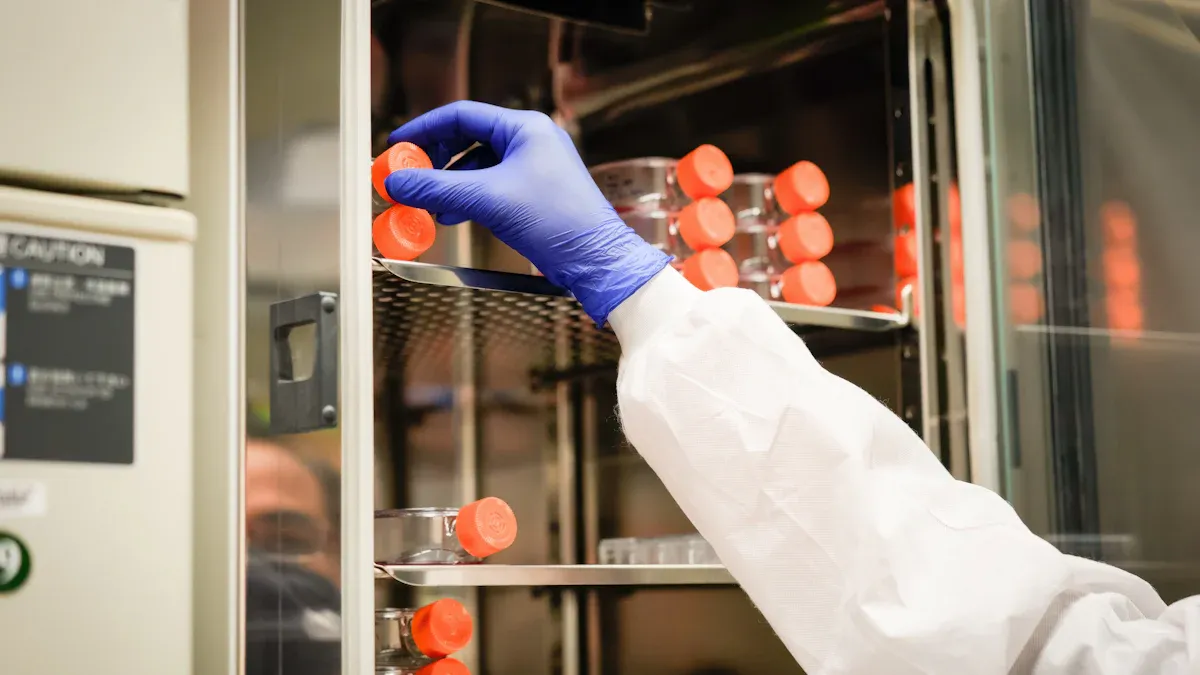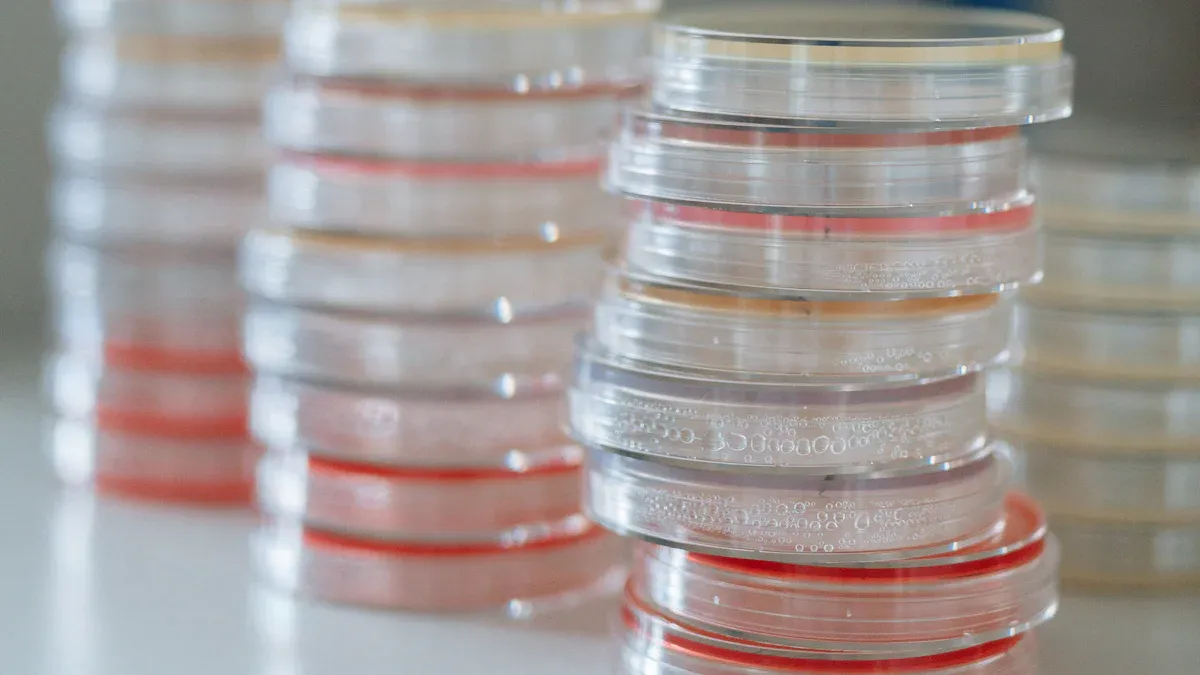
A biochemical incubator makes a special place for growth. It controls temperature, humidity, and gas levels. Scientists use this device to grow cultures. It helps grow bacteria, fungi, and other microorganisms. Many labs use a biochemical incubator to watch for infections. This is very important in newborn care. Some advanced systems, like electronic noses, find harmful microbes fast. They work inside these incubators. This helps doctors give better treatment.
Key Takeaways
-
Biochemical incubators make a safe place for growing bacteria, fungi, and cells. They keep the temperature, humidity, and gas levels steady.
-
These incubators have smart controls and sensors. They help keep the conditions the same. They stop germs from getting in. They also make it easy to watch and set up the incubator.
-
Temperature control is very important. Incubators keep the heat just right for growth. They can warm or cool samples for different tests.
-
Humidity and gas control stop samples from drying out. They give the right air for tiny living things to grow well.
-
Biochemical incubators are very important in labs, hospitals, and testing places. They help scientists get good results and make research better.
Biochemical Incubator Overview

Definition
A biochemical incubator is a special tool used in labs. It helps keep the right temperature, humidity, and gas levels. This makes it easier to grow things like cells and tissues. Scientists use a biochemical incubator to copy natural places where bacteria and fungi live. This helps them learn more about these living things. A biochemical incubator can also control carbon dioxide and humidity. This makes it good for experiments that need exact settings.
Note: Most biochemical incubators have smart sensors and controls. These help keep the inside safe for samples. They stop quick changes that could hurt the samples.
Functions
A biochemical incubator does many important jobs in labs. It gives a safe space for science work. Some main jobs are:
-
Keeping the temperature steady so samples can grow.
-
Controlling humidity so samples do not dry out.
-
Managing gas levels, like carbon dioxide, for cell and tissue cultures.
-
Lowering the chance of germs with HEPA filters and tight seals.
-
Letting scientists set and check the settings with easy controls.
-
Holding different containers, like flasks, tubes, and microplates.
-
Saving data and sending alerts if something changes fast.
Here is a table that shows the main jobs and features of biochemical incubators:
| Function/Feature | Description |
|---|---|
| Temperature Control | Keeps the temperature even so samples can grow and stay healthy. |
| Humidity Control | Controls how wet the air is so samples do not dry out. |
| Agitation/Shaking | Shakes samples gently to help some organisms grow better. |
| Programmable Parameters | Lets users set things like temperature and shaking speed for each experiment. |
| Contamination Prevention | Helps stop germs from getting in with special safety parts. |
| Versatility in Sample Holders | Works with many types of containers for different uses. |
| User-Friendly Interface | Makes it easy to use and watch the settings. |
| Data Logging and Connectivity | Saves and shares data so scientists can check on samples from far away. |
Lab incubators are very important in science, hospitals, and factories. They help people grow cultures, test water, and do experiments that need careful control. A biochemical incubator is better than basic lab incubators. It can control gas and humidity better, has HEPA filters, and can be programmed. These things help labs work faster and get better results.
How Biochemical Incubators Work

Biochemical incubators make the right place for scientists to grow living things. These machines use smart systems to keep the inside just right. They control temperature, humidity, and gases with special controls. This keeps the samples safe and helps them grow well. Every part of the incubator works together to help samples grow and give good results.
Temperature Control
Temperature control is a key part of a biochemical incubator. These incubators use special tools to keep the inside at the best temperature. This helps bacteria and other organisms grow. Many incubators have digital controls and use PID regulation. This checks the temperature all the time and makes small changes to keep it steady. Some incubators can heat and cool, which is called bidirectional temperature control. This lets scientists do many kinds of experiments.
Here is a table that lists some main temperature control technologies:
| Technology Type | Description and Features |
|---|---|
| Refrigerated and Heating Circulators | Give very exact temperature control from -50°C to +200°C. They can heat and cool quickly. |
| PID Regulation | Keeps temperature steady (±0.5°C) by changing heating and cooling as needed. |
| Proportional Cooling Control | Uses only as much cooling as needed, which saves energy. |
| Peltier Elements | Good for slow cooling, like when making protein crystals. |
| Jacketed Reactors with Circulators | Used in big setups to keep temperature even. |
| Air- and Water-Cooled Systems | Work in a wide range, from -45°C to +250°C. |
| Programmable Thermostatic Incubators | Let users set and keep the exact temperature and humidity. |
| Connectivity Options | Let users link to lab computers for better control and tracking. |
| Use of Natural Refrigerants | Help labs be more eco-friendly. |
Most biochemical incubators keep the temperature between 4°C and 60°C. This range is good for growing many bacteria and fungi. For example, the LB-14COI model can keep the temperature from 4°C to 60°C. These features help make the best place for living things to grow.
Humidity Regulation
Humidity control is also very important in biochemical incubators. These machines use a special pan to keep the air moist. The pan can keep the humidity up to 95% at 37°C. High humidity stops samples from drying out. This helps cells and tissues stay healthy. The incubator also uses heating from many directions and HEPA filters. These keep the air clean and the humidity steady.
If the incubator does not control humidity well, problems can happen:
-
Contamination and bad growth can ruin tests.
-
Cultures may dry out, which can hurt cells and make results bad.
-
Water pans help keep humidity high, but need to be checked and cleaned often.
-
Bad humidity control can waste time and supplies.
By keeping the humidity steady, the incubator protects samples and helps them grow.
Gas Management
Gas management in biochemical incubators helps make the right place for special microorganisms. Some incubators can use different gases like CO2, H2, and N2. These systems use exact controls to keep the right gas levels. For example, some incubators use CO2 flushing to take out oxygen and make an anaerobic space. This is needed for bacteria that cannot live with oxygen.
Modern incubators use vacuum sampling and tight seals to keep outside air out. They also use filtered gas intake to keep the air clean. Programmable controls let users set the right gas mix for each test. These features help make the best place for sensitive bacteria and other organisms to grow.
Gas management does more than just keep the right gases. It also helps measure how well microbes grow. For example, the amount of gas made during incubation can show how active the microbes are. By controlling gases, the incubator helps scientists study and grow many kinds of living things.
Features of Laboratory Incubators
User Controls
Laboratory incubators have easy controls for scientists. These controls help set and check the incubator’s conditions. Many incubators use a microprocessor PID controller. This keeps temperature and other settings steady. LCD screens show clear details. Users can program up to 12 steps for experiments. Programmable memory saves how the incubator works. This lets users run tests even when they are not there. Memory backup keeps data safe if the power goes out. Alarms warn users if something changes inside. The table below lists user control features and how they help:
| Interface Component | Description & Usability Enhancement |
|---|---|
| Microprocessor PID Controller | Makes sure the incubator stays steady and even. |
| LCD Interface | Shows information and lets users set programs and alarms. |
| Programmable Memory | Saves programs, dates, and timers for different experiments. |
| Memory Backup | Keeps saved data safe during power loss. |
| Built-in Alarms | Warns users if something is wrong inside. |
| Makes it easy to move through settings. | |
| Vacuum Fluorescent Display | Shows bright and clear numbers for easy checking. |
| Audible and Visual Alarms | Alerts users with sounds and lights if things change. |
| RS485 Signal Output | Lets users collect data for checking and control. |
Safety Systems
Safety systems keep samples and people safe in the lab. These systems stop germs and equipment problems. Many incubators use HEPA filters to clean the air. Alarms and temperature locks help stop trouble before it starts. Some incubators use low-VOC materials for special work. Cleaning and decontamination keep the chamber safe. Here are some important safety features:
-
HEPA filters lower the risk of germs.
-
Alarms and temperature locks stop equipment problems.
-
ISO or GMP standards make sure safety and quality are high.
-
Low-VOC materials help with sensitive work.
-
Cleaning and decontamination stop germs from spreading.
-
Infrared CO₂ sensors and special designs give extra safety.
Tip: Always clean surfaces and waste before sharing equipment to keep the lab safe.
Maintenance
Good care helps incubators work well for a long time. Cleaning with sterile disinfectants removes germs and stops contamination. Calibrating sensors every few months keeps readings correct. Users should change water pans and HEPA filters when needed. Data logs help track how the incubator works and find problems early. The table below shows important maintenance jobs and why they matter:
| Maintenance Task | Benefit |
|---|---|
| Regular cleaning and disinfection | Stops germs and keeps samples safe |
| Quarterly sensor calibration | Makes sure temperature and gas readings are right |
| Water pan and HEPA filter replacement | Keeps humidity and air clean |
| Performance tracking with data logs | Finds problems early and helps reliability |
Incubators that get good care give better results and help keep research safe and easy.
Applications
Microbiological Cultures
Biochemical incubators are very important in labs that grow cultures. Scientists use them to make the best place for bacteria and fungi. The incubator keeps the temperature, humidity, and gases just right. This helps samples grow for research and drug tests. It is also used for quality checks. Clinical labs use incubators to look for infections or study germs. HEPA filters and sterilization help protect delicate microorganisms. These features stop contamination and keep experiments trustworthy.
BOD Analysis
Biochemical incubators help with BOD analysis in environmental labs. BOD testing checks how much oxygen microbes use in water. The incubator keeps the temperature steady, usually from 5°C to 60°C. This is needed for good results. Digital PID controllers and LCD screens help set and watch the settings. The table below shows how these features help with BOD analysis:
| Feature Category | Description |
|---|---|
| Temperature Control | Keeps temperature steady within ±0.5°C for good BOD tests |
| Air Circulation | Moves air evenly so all samples stay the same |
| Contamination Prevention | Smooth edges and easy-to-clean insides lower the risk of germs |
| Alarms and Safety | Sounds and auto-shutoff protect samples from heat problems |
| Applications | Used for BOD tests, checking wastewater, and growing microbes |
| Benefits | Gives good results, saves energy, and is easy to use |
These features make the incubator a trusted tool for science and water labs.
Water Testing
Labs use biochemical incubators to test water for bad microbes. The incubator gives a safe space with the right heat and moisture. HEPA filters and high heat keep the chamber clean. Scientists can watch their tests live with touchscreens and data tracking. This helps them find germs or spoilage fast. Wastewater plants use incubators to help microbes clean water. Automation and data logs make work faster and help labs follow safety rules.
Tip: Clean and check the incubator often to keep it working well for every test.
Climatic Chambers Comparison
Environmental Control
Climatic chambers help scientists make special environments for experiments. These chambers can change temperature, humidity, and light. Users can pick many different temperatures for their tests. Climatic chambers also let users set humidity and light cycles. This helps with plant growth, testing materials, and drug studies.
Scientists use climatic chambers to see how samples react to changes. They might change the temperature or humidity to test products. Climatic chambers can keep the same environment for a long time. This lets researchers watch changes over days or weeks. Some chambers can copy day and night or even seasons with programmed cycles.
Note: Climatic chambers often work as constant temperature tools. They can keep the same environment for growing or testing samples.
A table below shows what climatic chambers can control:
| Variable | Control Capability |
|---|---|
| Temperature | Wide temperature range |
| Humidity | Adjustable |
| Light | Programmable cycles |
| Airflow | Even distribution |
Differences from Incubators
Climatic chambers and laboratory incubators both help with experiments and growing things, but they are not the same. Climatic chambers can change more things and have a bigger temperature range. Laboratory incubators are made for growing cultures and keeping the right place for bacteria or cells.
Climatic chambers are used for many kinds of research, like testing materials, studying plants, and drug tests. Laboratory incubators are mostly for microbiology and cell culture. Climatic chambers can copy tough or changing conditions. Incubators keep things steady for sensitive samples.
-
Climatic chambers:
-
Used for many types of experiments
-
Control temperature, humidity, and light
-
Copy different climates and stress tests
-
Laboratory incubators:
-
Used for growing microbes and cells
-
Focus on a small temperature range
-
Give a steady place for growth
Scientists pick climatic chambers when they need to test samples in many ways. They use laboratory incubators when they want to grow cultures in a safe, steady place.
Biochemical incubators are very important in labs and research centers. They make the right place for cells and microorganisms to grow. These machines help scientists and students get good results.
-
They keep the temperature and CO₂ levels the same for each test.
-
Smart controls and energy-saving parts help people work better.
-
Many labs, hospitals, and schools use them to learn and find new things.
Biochemical incubators help science move forward and support the needs of healthcare and research.
FAQ
What is the main purpose of a biochemical incubator?
A biochemical incubator helps scientists grow cultures. It keeps the temperature and humidity steady. This tool is used for research, drug tests, and clinical labs.
How do laboratory incubators differ from climatic chambers?
Laboratory incubators give a steady place for growth. They keep the temperature the same. Climatic chambers can change temperature, light, and humidity for different tests.
Can a biochemical incubator support different types of experiments?
Yes. A biochemical incubator can grow cultures for many uses. It works for microbiology, water tests, and drug tests. Users can set the temperature and humidity for each experiment. This helps scientists study many samples.
Why is temperature control important in cultivation?
Temperature control keeps the place steady. Living things need the right temperature to grow. Laboratory incubators use smart systems to keep this range. This protects samples and helps experiments work better.
What maintenance does a biochemical incubator require?
Cleaning and checking the incubator often keeps it working well. Scientists change water pans and filters to keep things steady. Data logs help watch how it works and find problems early.
https://www.schinstrument.com/biochemical-incubator-definition-functions-and-working-principle.html
